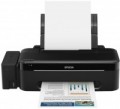Photo print
Printer print speed in photographic (highest) quality. Unlike other similar parameters, in this case the speed is usually indicated for a 10x15 sheet (A6, the most popular format for photographs). In addition, photo printing speed is not expressed in pages per minute, but in seconds per page, because. printing takes a lot of time. This option is worth paying attention to if you plan to
print photos frequently.
Mono cartridge resource
The maximum number of pages that the printer's ink (toner) can print. The value is rather conditional, in reality the deviations from the norm are very large (up or down). In inkjet printers, the cartridge life is relatively small and amounts to several hundred prints. In laser and LED devices, the bill is already in the thousands.
Colour cartridge resource
The maximum number of pages that the printer's ink (toner) can print. The value is rather conditional, in reality the deviations from the norm are very large (up or down). In inkjet printers, the cartridge life is relatively small and amounts to several hundred prints. In laser and LED devices, the bill is already in the thousands.
Ink type
— Pigment. Ink based on pigments — solid dyes, which are diluted in the form of microparticles in a liquid filler to a state of suspension. Compared to more popular water-based inks, these formulations are noticeably more expensive, and the finished image may turn out to be somewhat less bright (compared to printing with water-based dye on the same printer). On the other hand, pigment ink gives higher detail, which is especially important for photo printing. In addition, finished images resist moisture better and do not fade as quickly in bright light — this resistance is not enough for outdoor use, but indoors such prints can be stored for a very long time.
- Water soluble. Inks based on water-soluble dyes allow achieving high realism of color reproduction in color printing, they are well absorbed into the deep layers of paper and are cheaper than pigment ink. Also, water-soluble ink does not dry as quickly in the cartridge or print head of the printer. They are recommended for use with inkjet paper - ordinary thin paper strongly absorbs dropsy, which can cause ink to show through on the back of the sheet. At the same time, water-soluble inks are afraid of moisture and direct exposure to ultraviolet rays - when water gets in, the paint “floats” on paper, and it fades under sunlight.
– Pigmented / water soluble. Some printers have a print head that allows you to print with two types of ink at once. A common case is when their black cartridge is filled wi...th pigment ink, and the color one is filled with water-soluble ink.
Grammage (max)
The maximum grammage on which the printer can produce normal print quality. For details about the weight, see "Paper Weight (Min)". An attempt to print on paper of a greater density than the maximum for this printer will, at best, end in nothing (the printer simply cannot capture the sheet), at worst, it can lead to a sheet jam in the printer, followed by the hassle of removing it.
Output tray
The number of sheets of paper that the output tray can hold — the tray where the finished media is delivered. Usually, this amount is specified for standard office paper with a density of 80 g/m²; if you use thicker sheets, the actual capacity of the tray will be less (conversely, thinner sheets may fit more).

